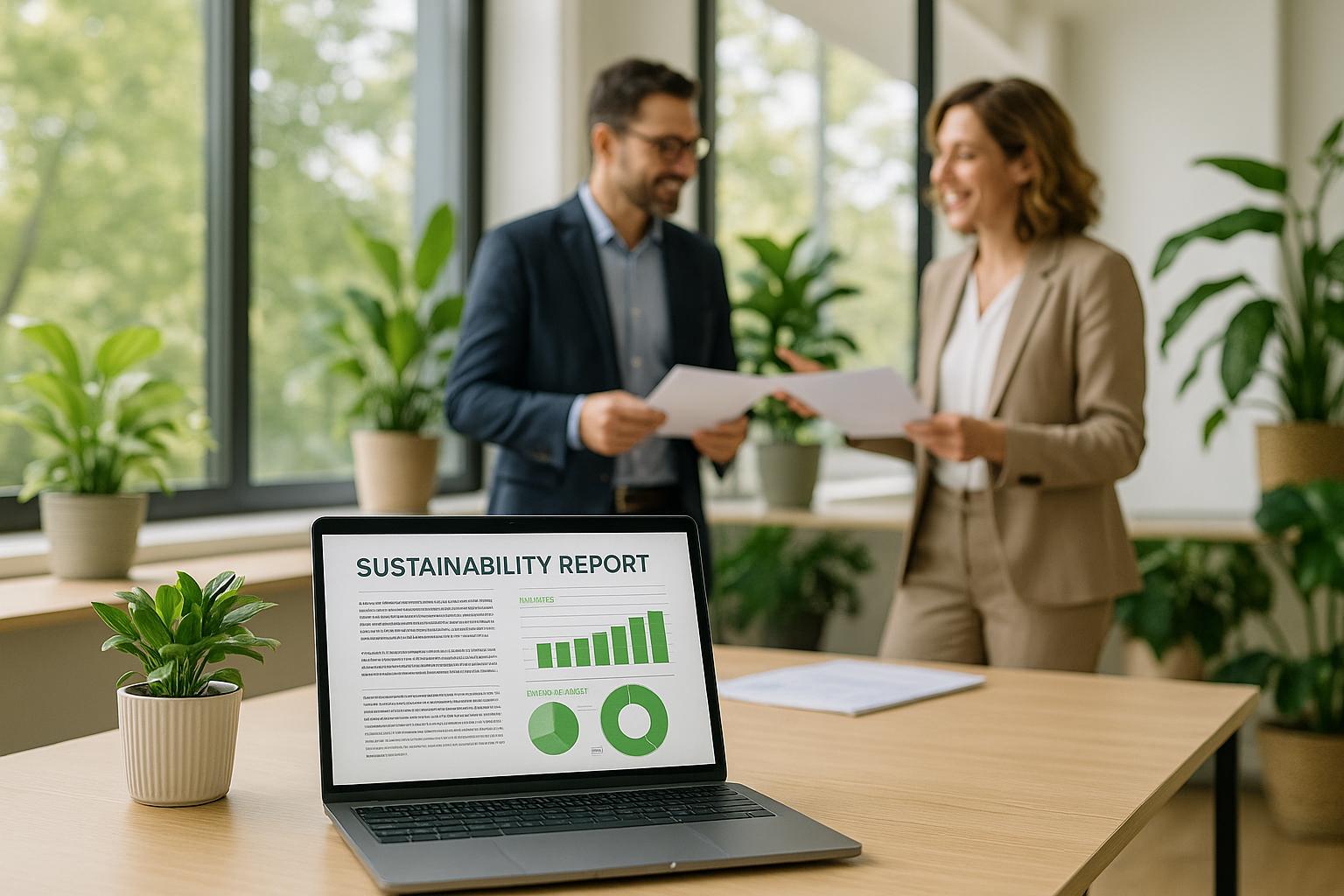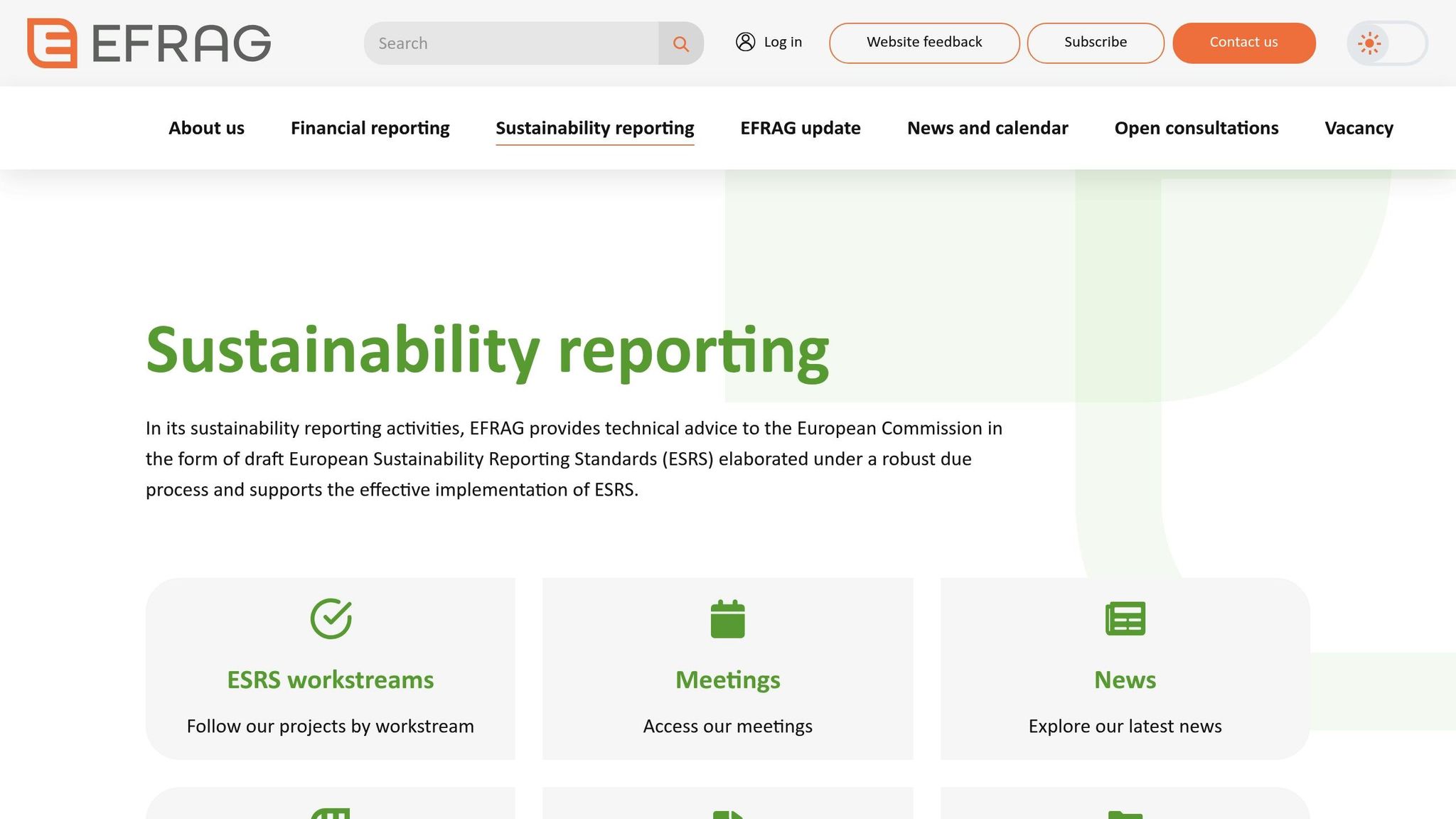ESRS 2025: 68% Fewer Data Points for SMEs - Simplified Sustainability Reporting
The new ESRS standards (EFRAG Exposure Drafts Set 1) significantly reduce the reporting burden for...
By: Johannes Fiegenbaum on 9/19/25 6:25 PM

Sustainability reports are more important than ever for German SMEs. With the new VSME standard, you can create these reports easily, efficiently, and without great effort. This approach, specially developed for SMEs, helps you meet legal requirements like the CSRD, build trust with business partners, and strengthen your position in the supply chain.
Conclusion: The VSME standard offers a clear, modular structure specifically tailored to the needs of medium-sized businesses. This way, you can professionally document your sustainability strategy while saving time and costs.
The VSME standard offers two modules: a basic module for getting started and an extended module that covers more in-depth information.
The basic module captures central metrics such as CO₂ emissions (in tons), energy consumption (in kWh), water consumption (in m³), as well as basic information about employees and governance structures. This data typically comes from already existing sources like energy bills, personnel statistics, or business reports.
The extended module is aimed at SMEs that already have experience with reporting or want to meet more detailed stakeholder requirements. It contains additional metrics such as waste quantities by categories, supply chain information, diversity data, and specific environmental goals. Companies can flexibly switch between modules or gradually incorporate individual elements.
After selecting a module, the targeted collection of ESG data follows, as described in the next section.
To optimally meet the requirements of German SMEs, the VSME standard covers four central areas:
Furthermore, the standard allows for adding industry-specific metrics. A manufacturing company could, for example, include material efficiency metrics, while a service company might focus on digital sustainability.
The VSME standard convinces SMEs through its cost efficiency, time savings, and flexible adaptability. Unlike comprehensive reports from other standards that often require expensive external consulting, the VSME standard can be largely implemented with internal resources.
A basic report can be created quickly without significantly affecting ongoing business processes. Companies can start with the basic module and gradually expand their reports. Already captured data is preserved and doesn't need to be restructured. This approach fits perfectly with the growth strategy of many medium-sized companies in Germany.
Flexibility, cost efficiency, and future security – these characteristics make the VSME standard the ideal choice for German medium-sized businesses. It provides a solid foundation to meet future regulatory requirements as well. In the next section, you'll learn how implementation works in detail.
Introducing the VSME standard is a clearly structured process that you can implement even without a specialized sustainability department. With these five steps, German SMEs can efficiently start their sustainability reporting.
The beginning involves clarifying reporting obligations. A materiality analysis helps you identify central risks, opportunities, and stakeholder expectations. Why is this important? Business partners, banks, and investors increasingly demand ESG information. These factors also play an increasingly important role in customer contacts, financing discussions, and in the supply chain. Additionally, regulations like the EU Taxonomy Regulation and the Supply Chain Due Diligence Act (LkSG) indirectly influence your reporting. Once you know your obligations, you select the appropriate module for your report.
The choice of module depends on your resources, stakeholder expectations, and strategic goals. The basic module is ideal if you're just starting with sustainability reporting or have limited capacity. For companies that already systematically collect ESG data, the extended module is suitable. It offers more detailed insights and meets higher requirements – without the scope of complex standards. You can start flexibly: Many companies begin with the basic module and later upgrade to the extended version. You can seamlessly continue using already collected data.
SMEs often face the challenge that neither specialized departments nor extensive resources or digital processes for data collection are available. A systematic approach is all the more important. You can often obtain ESG data from existing sources like energy bills, personnel statistics, or business reports. Modern AI solutions can support you in efficiently collecting data and recognizing relevant patterns. With well-organized data collection, you lay the foundation for the next phase.
The VSME standard offers you a modular structure that makes the reporting process clear and organized. Specialized software tools automate data collection, integrate various data sources, and automatically calculate metrics. They also create reports in the format you need. Templates provide you with a clear structure and ensure that all relevant information – from metrics to local formatting – is considered. With these tools, you can optimally prepare the collected data.
In the final step, all data is compiled into a clear report. This should contain the most important metrics, the methodology used, and an assessment of the results. Publication typically occurs as a PDF on your website or as part of your business reports. Your first VSME report serves as the foundation for future updates. With continuous documentation, creating future reports becomes significantly more efficient.
The VSME standard brings numerous benefits for German medium-sized businesses that are particularly tailored to the needs of small and medium enterprises.
Thanks to its modular approach, the VSME standard allows for an uncomplicated entry that doesn't require high investments or the use of expensive external consultants. The processes are designed so that existing employees, supported by clear guidelines and standardized procedures, can handle report creation. This not only saves time but also significantly reduces personnel effort. Additionally, transparent reporting leads to better communication with your stakeholders – real added value for your company.
A transparent ESG report creates trust with business partners and banks. Through clearly documented sustainability measures, stakeholders can better understand and evaluate your corporate efforts. A professional presentation of sustainability goals also strengthens communication with customers and helps stabilize business relationships long-term.
Unlike the more complex requirements of CSRD or ESRS, the VSME standard offers a significantly simplified approach. It meets basic compliance requirements without burdening SMEs with extensive and often difficult-to-implement regulations. At the same time, the standard remains flexible and adaptable for future requirements through its gradual expansion.
Successful VSME reporting depends on proper application, skillful integration into your existing processes, and regular adjustment of your ESG strategy. Here you'll learn how to effectively integrate the VSME standard into your workflows.
For VSME reporting to function smoothly, it should be integrated into your existing workflows. It's worthwhile to use already existing ESG data from areas like accounting, human resources, or quality assurance. This helps avoid duplicate work.
It makes sense to designate fixed contact persons who are responsible for regularly providing ESG data. This saves time and ensures that information is captured directly at the source.
Digital tools and standardized templates that comply with VSME standards also make the work easier. They enable systematic report creation and help efficiently use the standard's modular structure. Regular ESG analysis can also facilitate strategic decisions and strengthen collaboration within the company.
Since the VSME standard is continuously being developed, it's important to regularly adapt your reporting. For example, in December 2024, the number of modules was reduced from three to two and the reporting points from 28 to 18.
You should align your strategy with the new materiality criteria and reporting requirements. Measures like a materiality analysis or preparing the ESRS-VSME report offer immediate added value and can be reused for future reporting obligations.
Also keep an eye on changes to ESRS and CSRD to keep your reports always up to date. A current report forms the foundation for identifying further optimization opportunities through targeted consulting.
Sustainability reporting is complex and regulatory requirements are constantly changing. Here, collaboration with experienced consultants can be a great help. Companies like Fiegenbaum Solutions offer consulting specifically tailored to SMEs and valuable insights into regulatory requirements.
An experienced VSME consultant supports you in selecting the right module level and defining your specific requirements. This helps avoid common mistakes, and your reports not only meet current standards but also create strategic value for your company.
Especially during the first implementation, investing in professional consulting pays off. Consultants help you build efficient processes for data collection, select suitable digital tools, and develop a comprehensive sustainability strategy. This external expertise complements your internal efforts and lays the foundation for you to create future reports independently. This makes your reporting not only more sustainable but also more efficient in the long term.
The VSME standard offers SMEs the opportunity to create their first sustainability report efficiently and without high costs. With a clear strategy and suitable tools, you can start quickly. Here you'll learn which tools make getting started easier.

The EFRAG tools are specifically designed to simplify entry into VSME reporting:
In addition to the free tools from EFRAG, there are also specialized platforms that offer additional functions:
The European Commission has officially recommended the VSME standard. Regular updates and new automation tools ensure that you'll be well-positioned in the future as well.
Start with the basic module and use the free EFRAG tools for your first report. Accompanying materials like explanatory notes and an introductory video help you with implementation. If you have more complex requirements, Fiegenbaum Solutions offers support to expand your ESG strategy beyond mere compliance.
Starting now means taking an important step toward a sustainable future. The VSME standard can become a central component of your long-term ESG strategy and optimally prepare your company for upcoming requirements.
The VSME standard was specifically designed for small and medium-sized enterprises (SMEs) and stands out through its simple handling and manageable scope. Instead of imposing a multitude of complex requirements, this standard focuses on only 75 essential data points and forgoes elaborate double materiality assessments. This significantly reduces effort – a crucial advantage for SMEs.
The standard takes into account the often limited personnel and financial resources of SMEs. It offers a practical way to create sustainability reports and comply with ESG requirements. At the same time, it remains flexible and focuses on topics that really matter for SMEs – without unnecessary bureaucracy or high costs. An approach that puts efficiency and relevance in the foreground.
The VSME standard offers small and medium-sized enterprises (SMEs) a practical and cost-effective way to specifically strengthen their ESG strategy. With its standardized sustainability reporting, it creates more transparency and strengthens trust with business partners and investors.
Additionally, the standard simplifies the processing of ESG questionnaires, which can significantly improve financing opportunities. At the same time, it supports companies in strategically aligning themselves with sustainability – an important step to remain competitive and efficiently meet regulatory requirements.
The implementation of the VSME standard can be significantly facilitated for SMEs with targeted support. There are practice-oriented guides and consulting services specifically tailored to the requirements of small and medium-sized enterprises. These tools provide you with clear implementation instructions and help make the process efficient and manageable.
Furthermore, webinars and digital tools are available to support you in creating sustainability reports. These tools not only help meet legal requirements but also enable strategically aligned ESG reporting that can secure long-term competitive advantages. Use these resources to make entry into the VSME standard as straightforward as possible.

ESG & sustainability consultant specializing in CSRD, VSME, and climate risk analysis. 300+ projects for companies like Commerzbank, UBS, and Allianz.
More aboutThe new ESRS standards (EFRAG Exposure Drafts Set 1) significantly reduce the reporting burden for...
German SMEs are transforming the ESG landscape – without loud campaigns. Instead of investing...
Want to make your ESG reporting more efficient? With the VSME Standard, you can create leaner and...